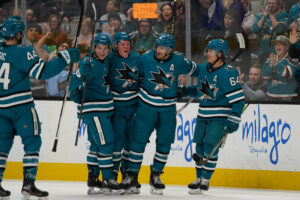Over the last several months, I have been crunching numbers, trying to solve the many questions of player development. With that, we here at Last Word On Hockey will be starting a new series on how to properly develop prospects from all different spots throughout the draft.
All advanced stats in this piece were taken from Evolving-Hockey.com.
Player Developments of Top Three Picks
From 2005-2015, there have been 24 draft picks used on forwards from North American junior teams in the top 3. The focus was directly on North American prospects for the sake of comparing stats. I separated those 24 forwards from the rest of the top 3 picks in that span. Then, I looked at their DY-1 stats, the season before they get drafted, and their DY stats. I averaged out their points per game in their DY-1, DY and beyond, if necessary, and color-coded them. The four sections were “well-above average,” “above average,” “below average” and “well-below average.”
Based on the sections they landed on before they played 15 or more games in an NHL season, they were separated into categories. The categories were “Forwards deemed NHL Ready,” “Forwards nearly NHL Ready,” “Slightly Rushed,” “Rushed,” “Forced,” “Teams were Patient,” and “Teams were way too patient.” Three forwards fell in the “rushed” category, and those were Ryan Nugent-Hopkins, Alex Galchenyuk and Leon Draisaitl.
Player Development of Ryan Nugent-Hopkins
Playing in the WHL, Nugent-Hopkins posted a 0.97 point per game pace in his DY-1 season. That pace, compared to other top-3 picks from 2005-2015, was deemed well-below average. In his DY however, Nugent-Hopkins broke out in a big way, posting a 1.536 point per game pace. Despite that big jump, he posted below average for DY paces. Despite playing comparatively worse, looking nowhere near NHL-ready, he was drafted by the Edmonton Oilers and thrust immediately into an NHL role.
How Was Nugent-Hopkins Used?
In his first NHL season, “Nuge” played 62 games averaging 17:36 time on ice per game. For a rookie, that is a massive role. In that role, Nuge posted 18 goals and 34 assists for 52 points. He finished second in Calder Trophy voting. Analytically, Hopkins was also steady, posting an Even-Strength Offense (EVO) score of 6.4 and an Even-Strength Defense (EVD) score of -2.2. Meanwhile, he finished with a Wins Above Replacement (WAR) of 1.5 and a Goals Above Replacement (GAR) of 8.6.
Despite his production, Nuge was relegated to just 40 NHL games and 19 AHL games. He averaged more ice time, however, at 18:52 per game. He posted 4 goals and 20 assists for 24 points in those 40 games, while adding 8 goals and 12 assists for 20 points in those 19 AHL games. In his second season, Nuge saw his analytics decline. Posting a 1.5 EVO, -0.9 EVD, 1.1 WAR and a 5.8 GAR.
In his third season, Nuge played 80 NHL games, averaging 20:24 time on ice per game. In that role, Nuge scored 19 goals and 37 assists for 56 points. He also posted an EVO of 5.8, an EVD of -3.5, a WAR of 1.1 and a GAR of 5.8, returning to his rookie year form, sort of.
Player Development of Alex Galchenyuk
Galchenyuk was an interesting case, as he posted an above average DY-1 season with a 1.221 point per game pace. However, in his DY, Galchenyuk played just 2 games with 0 points, landing him in the well-below average category. Yet, he was still taken third overall by the Montreal Canadiens. He would play 33 OHL games following the draft, before finishing the NHL season with 48 games in the season following the draft.
How Was Galchenyuk Used?
As stated above, Galchenyuk would play 33 OHL games, where he would produce 61 points, including 27 goals. Then, when he made the jump to the Canadiens roster for 48 games, he would score 9 goals and 18 assists for 27 points. He averaged a mere 12:19 of time on ice per game. He would also score well analytically, with a 7.8 EVO, 0.2 EVD, 1.2 WAR, and 6.4 GAR.
In his second season, Montreal gave Galchenyuk a slight raise in ice time, while playing in 65 games. He averaged 14:24 time on ice per game. In that slight raise, he scored 13 goals and 18 assists for 31 points. Analytically, he declined to just above replacement level. His EVO was 1.2, and his EVD was -0.3. His WAR dropped to just 0.5, while his GAR dropped to 2.5.
Despite the analytical decline, the Canadiens stuck to their plan for the third overall pick. He would play in even more games, this time slotting into 80, averaging a bigger role once again, with 16:26 of time on ice per game. He recorded 20 goals and 26 assists for 46 points in those games. Analytically, he posted a 7.3 EVO, -3.2 EVD, 1.5 WAR, and a 7.6 GAR. Those are all solid, but not sensational, numbers.
Player Development of Leon Draisaitl
Leon Draisaitl, getting drafted third overall in his draft year by the Edmonton Oilers, was playing junior hockey in the WHL. He went on to record a point per game pace of 0.906 in his DY-1 season, landing in the well below average category. He followed that up in his DY with a 1.641 point per game pace, but still landed in the below-average category in this model. Despite not being NHL-ready based on this model, the Oilers threw Draisaitl into game action that very season following the draft.
How Was Draisaitl Used?
Similar to Galchenyuk, Draisaitl played 32 games in the WHL in the season following the draft. However, while Galchenyuk finished the year in the NHL, Draisaitl started the season in the NHL. He played 37 games, scoring 2 goals and 7 assists for 9 points, averaging 12:42 of ice time per game. He posted below replacement-level in all analytics, with a -1 EVO and EVD, -0.3 WAR and a -1.4 GAR. Draisaitl wound up playing in juniors due to his struggles. That is due to the fact he was ineligible to play in the AHL. He scored 19 goals and 34 assists for 53 points in those 32 games.
The following season, Draisaitl played in 72 NHL games, averaging a LOT more time on ice, with an average of 18:03 per game. It did not come without hiccups though, as he had a 6-game AHL stint, where he scored just 1 goal and 1 assist for 2 points. Despite being below replacement level last year, and having a rough go in the AHL, the Oilers remained confident in Draisaitl and they reaped the rewards. He scored 19 goals and 32 assists for 51 points in those 72 games. Additionally, he scored an 8.2 EVO, -2.3 EVD, 1.7 WAR, and 8.6 GAR.
The best was yet to come, however. In his third NHL season, Draisaitl would play a full 82 games, averaging another increase in time at 18:53 per game. He scored 29 goals and 48 assists for 77 points in that role. He also scored an 11.5 EVO, -1.2 EVD, 3.2 WAR, and a 17 GAR.
Where Are They Now?
Of the three mentioned, it’s easy to see how Draisaitl is the best. In fact, The Athletic ranked Draisaitl in the MVP category as a tier 1B player in the NHL, while Nugent-Hopkins was placed in the 4C tier and Galchenyuk was unranked.
The Oilers Picks
Draisaitl was handed the biggest raise amongst the three mentioned from year one to year two. The Oilers plugged him into the lineup and waited out as long as they could to see if Draisaitl could hit a stride. He never did, and instead of demoting him to a lower line and hurting his confidence, they sent him back to Juniors, where he dominated. Then he played a large role the very next season, after a pretty abysmal rookie campaign, and it worked out. From there, they paired Draisaitl up with strong players, including Connor McDavid.
Ryan Nugent-Hopkins played the biggest role to start with and saw a raise with each passing year. He has consistently been a solid top-six forward for the Oilers, putting up between 40 and 60 points every year, up until the last two seasons, where he has surpassed that 60-point plateau. The issue with Nugent-Hopkins is that Taylor Hall was his linemate and aided his growth, but once he left, McDavid took over as the top line center. Nuge is still a great player, but he hasn’t personally taken that next big leap in development and his role is held back with McDavid, and even Draisaitl, in the mix. However, he is an exceptionally good top-six forward thanks to the way he was developed in his first three seasons.
Alex Galchenyuk’s Bumpy Road
Finally, Alex Galchenyuk. After hitting the 16:26 mark and seeing a steady raise each passing season with Montreal, he would never surpass that ice time again. He would play another three seasons in Montreal, averaging about 50 points in those three years. Since then, he has played for three other teams. He played for the Arizona Coyotes in 2018-19 for 72 games, playing under 15 minutes a game. He would then play for Pittsburgh, where he would play 45 games, playing 11:29 per game, before being dealt to Minnesota, playing 14 games and averaging under 15 minutes. Galchenyuk signed with the Ottawa Senators this off-season. He is certainly a guy who is going to be involved in a trade for assets at some point in the upcoming season.
Ultimately, Galchenyuk peaked in his third season. He was not given the best linemates. Galchenyuk was playing with Brendan Gallagher, Tomas Fleischmann, Phillip Danault, and Artturi Lehkonen in Montreal. Then, in Arizona, he played with Vinnie Hinostroza and Brad Richardson. When he played in Pittsburgh, he was often with Evan Rodrigues and Nick Bjugstad. Finally, in Minnesota, he was with Marcus Foligno and Jordan Greenway. Clearly, the lack of talent surrounding Galchenyuk has not helped, and neither has his lack of ice time. If Senators coaches give Galchenyuk the reigns of the first line with Brady Tkachuk, watch out. Tkachuk is arguably the best linemate Galchenyuk has been with in his career. He could break-out. It is unknown if Galchenyuk’s going to play with Tkachuk this season, however.
Main Photo:
Embed from Getty Images






